Originally published to the SEGA Blog on Nov 25, 2013 – republished here for archival purposes
We are extremely excited to present to fans a series of interviews on our upcoming 3D Classics on the Nintendo 3DS. The interview originally took place across the Game Watch and Impress website, featuring both Yosuke Okunari from Sega of Japan and Naoki Horii from the developer M2. These interviews show not only the care that went into making the absolute best versions of these titles on the 3DS, but also a lot of the technical challenges in creating 3D versions of our classic SEGA games.
Big thanks to Game Watch and Impress, Okunari-san, and Horii-san for their involvement in making these interviews available to our western audience. We hope you enjoy these interviews and encourage you to feedback with your own questions or comments. Let’s begin with Space Harrier and information on how the project got started…
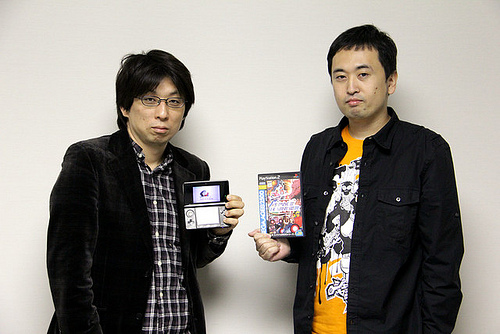
– Alright, let’s start by talking a little about this company called M2. Horii-san, do you mind?
Naoki Horii (below NH): Talk to people in the game industry and you’ll find out that everyone was a “gamer kid”. We’re no different ourselves, and our company’s first actual game was a MegaDrive title called Gauntlet[1]. That was a game that you could play with four people, and some friends and I from school and the local arcade got together and built a copy of the game from memory. We remade it exactly as we remembered it, took it to a company called Tengen, and finally got the money we needed to buy the materials we needed. Just like that. So our first game was a highly faithful port of the arcade version. You could call it a ‘copy by eye’ since we remade what we saw. That’s where I started, and here I am twenty years later, happy with what we’ve accomplished.
Yousuke Okunari (below, YO): He just wants to port the game he loved…
NH: Back in those days, arcade games were expensive and you couldn’t just buy them. Not only that but you had to keep feeding 100 yen coins into them. Even if you went and bought a port, it wouldn’t be the same thing. You’d think to yourself “Something’s just different.” We wanted it to play games as close to the original as possible, and eventually we figured we should just do it ourselves.
[1] Gauntlet was an action fantasy RPG game released by Atari in 1985. The MegaDrive version was released by Tengen. The MegaDrive version was released in 1993 and was called Gauntlet IV overseas.
– So it all started with Gauntlet.
NH: Back then, there wasn’t a good port of Gauntlet, so you couldn’t play with four players at home yet. Everything started once we thought “hey, we probably know this game well enough to build it.”
YO: Then eventually they started working with us (SEGA).
NH: Back in the time of Gunstar Heroes on the Game Gear, there was a SEGA employee named Hiroshi Aso. He approached us and said “Wow, you made Gauntlet, huh? Well how would you like to work on Game Gear? Go ahead and pitch a couple games you’d like to do.” So we suggested a game called Edward Randy[1]. If you think about it, Gunstar Heroes is just an improved version of Edward Randy. So porting that to the Game Gear was our first job with SEGA.
YO: Gunstar Heroes is often regarded as a game that really pulled out all the stops when it comes to the MegaDrive’s capabilities, and trying to port that to the Game Gear was no small task. By the way, the Game Gear version is available in the Gunstar Heroes: Treasure Box, on sale now[2] via PS2 Archives. You have to use a cheat code to play it though… (laughs)
NH: So we had a break from working with SEGA for about 4 years, and then we worked on the Windows version of Sakura Wars. We also helped out a bit on the Dreamcast version as well. The first time I saw the Saturn version, I thought to myself “Oh boy, this game is just massive”, and I definitely remember how much of a rough time we had on that project.
YO: After the Dreamcast version of Sakura Wars, M2 was doing other projects for a while. Then a PS2 action adventure game called Project Altered Beast came along, and internally we had the idea of including the original Altered Beast in the game as a bonus feature. It just happened that M2 was working on a port of the arcade version of Altered Beast at that time.
NH: We were trying to port it by ourselves, you know. I just had a hunch that something like this might come up, so we went ahead and ported it without being asked to. That’s how we got started, right?
YO: Yeah, but the whole “put Altered Beast in Project Altered Beast” thing died on the drawing board. However, the fact that M2 could do ports got shared around internally at SEGA. So for Sega Rally 2006, the idea of putting the original Sega Rally in the game came up, and M2 was basically a silver bullet. Right around that time, AM2[3] was working on a port of Virtua Fighter 2 for SEGA AGES 2500, so we had a ported Model2 engine available. However, there weren’t any production lines open for Sega Rally and AM2 couldn’t get around to it. So then we asked M2 if they wanted to handle it.
NH: That was just learning from imitation, though.
YO: This wound up being M2’s first PS2 job with SEGA. For VF2, AM2 basically used an emulation-style implementation, but the Sega Rally’s arcade board was a later version than VF2, so it wouldn’t run as-is. M2 analyzed the game engine on their own, and rebuilt the game in the process of porting Sega Rally. In the end, it took a while to get Sega Rally 2006released and it ended up coming out later than Space Harrier. VF2 had been received really well, and we decided to continue the ports this way for the SEGA AGES 2500 games. Right after I’d finished up on Dragon Force, we got the OK to continue on with the series. We were talking to a lot of developers in order to build the next lineup of ports, and that’s when I met them for the first time.
[2] Known as The Cliffhanger: Edward Randy overseas. Released only in Japan in 1990 by Data East.
[3] This a reference to Sega Ages Vol. 25: Gunstar Heroes: Treasure Box, a PS2 game only released in Japan.
[4] AM2, short for Amusement Machine R&D Department 2, is one of SEGA’s development teams. They are responsible for many of SEGA’s popular franchises such as Virtua Fighter, Shenmue, Daytona USA, Project DIVA Arcade games.
– Oh really? Wow that’s unexpected.
YO: So from there, the idea of porting Altered Beast for SEGA AGES 2500 came up. But just doing an Altered Beast port as a packaged title would be kind of hard sales-wise, so we ended up having M2 port S.D.I & QUARTET[1], although in the end there probably wasn’t much of a sales difference between the two. (laughs) Next we said, “Hey, let’s do Space Harrier. Its hardware is pretty close to SYSTEM 16[2].” From there, we had M2 work on a couple of titles for us. And that’s how SEGA AGES 2500 Space Harrier II was born, which was released on PS2 Archives about 7 years ago.
NH: It still impresses me how much we code in assembly[3] even now. Our staff is really incredible…
YO: They showed me what were basically finished versions of Altered Beast and Shinobirunning on SYSTEM 16, and though the sound wasn’t working yet, I figured if it was running this well, they’d have it up and running in no time. Boy was I wrong…
NH: When we tried to accurately reproduce all of SYSTEM 16 on a PS2, we couldn’t get the FM sound sources to fit in. When we thought about where to onload those, we remembered the PS2’s I/O Processor (33MHz) for the PS backwards compatibility feature. So we banged out some assembler code for it and got the FM sound source working. (For details check out Sega Voice Vol.15)
YO: It was Space Harrier’s 20th anniversary at the time, and since it’s a game from 20 years ago, we figured that the PS2 would have no problem running a game like Space Harrier. I mean, it ran on the Dreamcast after all (it was in Shenmue), but that’s just not how it worked out. The ins and outs of emulating things were still being figured out back then. Being new to this, even I thought we could churn out ports pretty quickly, but it turns out that wasn’t really the case.
It turns out that since the hardware is different, it takes quite a lot of machine power to emulate these games. M2 is quite fussy about these kinds of things, and they wanted to really get the controls right from the get-go. In other words, eliminating input lag. Around this time, people were really concerned about this term “input lag”. They’d say “really, the hard part is reducing input lag as much as possible.” Space Harrier is actually one of the easier titles in this sense, but for other games, reducing input lag is a big task and took up a lot of our time.
NH: There are a lot of situations where if we could just slow the processing down by a single frame, everything would be much easier.
YO: Sort of like how when you use a number of polygons at 60 frames per second, and then run the program at 30 frames per second, you can use twice the number of polygons?
NH: Yeah, it’s kind of similar, but with input lag, you have to grind away on a lower program layer. If you can get just 1 more frame worth of time, you can do what you can during that frame, which makes things easier.
YO: Also, while we were trying to port the arcade version of Space Harrier, I thought releasing the port for 2,500 yen ($25) might be a little tricky since a remake already existed. I wanted to have some other versions ported as well, and since M2 had made progress on MegaDrive and Mark III emulation, so we decided to make a bundle. But due to some concern that there’d be some confusion with the remake being released first, we added “II” to the title.
NH: We had this idea that if people thought the game was Space Harrier II from the MegaDrive, they might not pick it up. Actually, I remember Okunari-san saying “If we port this, people will be able to play it not only on the PS2, but on 3 and 4 as well.” Well, now you finally can play it on all versions on the PS3 I guess. (laughs) When the backwards compatibility feature was removed from the PS3, we were a little worried. (laughs) But now we’re in an age where all that work is available for 800 yen (~$8).
YO: The Game Gear version is also in SEGA AGES 2500 Space Harrier II as a hidden feature now, but at the start we had no intention of doing that. Namely because the Game Gear version is a downgraded version of the Master System one, and since it was built for a portable game system, the resolution wasn’t great for playing on a TV screen. Still, M2 said they wanted to include everything they could. However, since the hardware specs for the Master System and Game Gear differ, M2 couldn’t get the Game Gear version working and were about to give up on it. But we got it in at the very end.
NH: 7 years ago, my take on it was: “I don’t want to buy Space Harrier again.” I wanted to make a version that had everything you need. (both laugh) Then later on we wound up developing the Wii and 3D versions. At this point I hope I can just ask for everyone’s forgiveness since I buy them all myself. (both laugh)
YO: Yeah we’d not planned to develop the Game Gear version at the start, but once we got past beta[4] it was like “Game Gear version got in on time! It’s done!” however it really wasn’t on time at all. (laughs) The manual was already done, and the release date was set so we couldn’t advertise it at all. So we wound up making it an unlockable feature and said: “Oh well, you get another game in there, it’s just hidden away.” But as a result, it seems that people thought that every installment of the PS2 SEGA AGES 2500 series had to have some sort of extra game in it.
NH: You were really brave to hear us out there at the very end.
YO: Well, you still send me outrageous requests even now… (both laugh)
NH: Oh I don’t know. I think we’ve gotten better…
YO: That’ll be the day! (laughs) But anyways, this theme of specs changing while M2 builds the ports certainly echoes down the line.
[5] SDI is a shooting game released in 1987 for Arcade and later the Master System. Quartet is a side scrolling shooter released in 1986 for Arcade and the Master System.
[6] SYSTEM 16 is a 16-bit arcade board released in 1985 that ran games like SDI, as well as Golden Axe, Fantasy Zone and Shinobi. Space Harrier runs on the same board as Hang-On, which is similar to System 16 but with more processing power.
[7] Assembly code is one step above coding directly in machine code. It’s generally considered very difficult to work with.
[8] Beta is a development milestone state that generally indicates the game is functionally complete, but there are bugs and glitches that need to be fixed before the game can be released.
– So the scene was set by SEGA AGES 2500 Space Harrier II.
YO: One of the most last-minute moments we had was with Fantasy Zone Neo Classic in SEGA AGES 2500 Fantasy Zone Complete Collection. Neo Classic was based on a game originally made by Sunsoft, so we had to rush to get a contract in place with them. (laughs)
NH: Oh really?
And the mysteries of Space Harrier keep on coming!
YO: Back to the subject at hand, Space Harrier was ported to the PS2 with M2’s considerable technical skill and all was grand. For a series based on older game ports, I thought we had a great launch, and we got a lot of feedback.
One instance that particularly surprised me was when we put S.D.I. & Quartet and Space Harrier II out for display at the Tokyo Game Show. Since it was our first time showing off the full version in front of customers, I was at the booth myself. The first people to stop by on the first day were M2’s first SEGA supervisor, Aso-san, who was also the developer for the original arcade version, as well as two developers from ”Game Rotsubo”, who ported Space Harrier for the Super 32x and Sega Saturn.
– Whoa!
YO: I didn’t even have time to be surprised before one of the guys started playing. These guys are legends to me. They brought Space Harrier to the 32X and Sega Saturn, which had had much lower specs than the PS2. These guys played our PS2 version, with eyes as big as dinner plates. I mean, you know these guys LOVE Space Harrier to death, so of course they are going to be interested in people who work on it. So they played up to Stage 7 (Lucasia: where the mammoths come out), and then I heard one go, “Ah!”
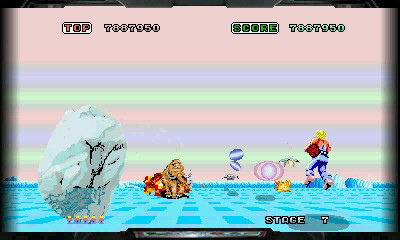
So I got all nervous, thinking “Oh man, what…” and then asked them about their impressions after they’d finished. They gave it their seal of approval, saying “It’s really well done.” But then they said “There’s one thing. On stage 7, there are these slanting boulders in the background. The issue is with the background horizon…. you see the boulders are supposed to be on the ground, and are only supposed to be displayed below the horizon line, and when Harrier runs on the ground, they’re clipping into the horizon line. If the line goes up, there’s a bug where the color gets a little weird and turns slightly black. That isn’t happening on this PS2 version.”
NH: In this case you’re seeing the correct graphic on the PS2 hardware, but that’s because it differs from the architecture of the original Space Harrier’s hardware.
YO: That’s how the boulders in the first half of the 7 stage display. The original staff said “it’s a bug, but it was pretty how the boulders sort of twinkled.”
– Huh, how about that.
NH: I don’t know if anyone else has pointed that out, but their comment was the first time we’d heard about it.
YO: I think in the end, they were probably the only ones who pointed it out. In any case, being a newbie myself, I wound up thinking the port had a long way to go, and we could do even better. Oh and there was another problem that came up regarding the height of the horizon line. We addressed this with the “Harrier’s moving area” option in 3D Space Harrier.
When the PS2 version was released, we saw comments on the net saying that if the player sits at the highest position on screen, the horizon line’s uppermost position would differ from the arcade board. We thought “Well, we built the game to the exact spec of the original, so why are people seeing differences?” At the time, we had no idea why. That and the sound quality. People said that the sound isn’t the same as the OST CD or the arcade version. Amps and other equipment will make it different from the arcade version at a very basic level anyways, but since M2 wanted to make sure there was no input lag they had to use some of the game’s processing power to eliminate it, and that slightly weakened the sound quality.
NH: From that point on, there were probably some games we worked on where there’s a difference in audio between the game and the Sound Test menus. If you noticed that, let us know. It’s easier to lighten the processor load in a Sound Test menu.
YO: You can hear the difference in the hidden sound mode in PS2’s Fantasy Zone Complete Collection.
NH: Yeah, I seem to recall we did it there.
YO: M2 is getting better at this, and the quality’s also rising since we are devoting more of the console’s processing power to sound emulation.
– Interesting (laughs). So it sounds like in your experience, the game’s sound quality was limited by the power of the console, to the extent that you were performing calculations internally and then outputting the sound.
NH: When using streaming output, you can’t reproduce the behavior where some sounds would disappear due to sound effects being played. It depends on the game, but a lot of people actually like that effect. We wanted to cater to that need. But if streaming is the best option for a particular game, we’ll go with that.
– You used both approaches in Galaxy Force II, right?
YO: Well for that collection, there weren’t that many titles included, so we thought we’d give it a shot. So yes, there’s a streaming version and an internal sound source version. Oh, and an FM Towns[1] version. (laughs)
NH: For the streaming version of Galaxy Force II, we had a guy at Wavemaster record it for us, so it turned out really nicely. At that point we found out that the original PCB version outputs the L/R channels backwards. (laughs) Since the original was backwards and thus ‘correct’, we matched this up with the arcade speaker specs.
[9] The FM Towns is a PC variant made by Fujitsu that specialized in multimedia applications. Galaxy Force was released on the FM Towns with CD-DA streamed music.
– There’s always something, huh?
YO: So anyways, after releasing Space Harrier II on the PS2 in 2005, we decided to release Space Harrier onto the Virtual Console Arcade in 2009. Being blessed with another chance to release the title, we wanted to make sure the Stage 7 bug could be reproduced, as well as put some extra effort into the sound. We also wanted to look into the Analog Stick and Horizon Line problems.
– So you finally got a chance to poke around this mystery, eh?
YO: On SEGA’s side, we have a Space Harrier machine that we keep for cataloguing purposes, so I actually went down and played it in the warehouse. And it’s true; the horizon line in the PS2 version is higher than the arcade version. It was different. On the original machine, the Tomos enemies that appear in the 1st stage are easier to shoot. I wanted to know why the arcade version was so different, so I went into test mode to take a look and noticed that when I pulled on the stick, the analog input wouldn’t max out. Which means that the controls were programmed that way to move the cabinet.
When we made the PS2 version, we did look at the original arcade board, but we didn’t actually look at the full arcade cabinet. That’s why it’s different. So for the Wii Virtual Console Arcade version, we took the arcade control differences into account. The Wii version can be controlled using the nunchuk, after all, so for us, the Wii version was the one we were most satisfied with.
– So finally that puzzle was solved!
YO: But even after implementing the control corrections, we still got comments saying it wasn’t right. Something was still wrong with the horizon line. Now it was too low! We had players saying “You got it right on the PS2 version, so why couldn’t you do the same for the Wii version?” I decided to visit as many arcades that had Space Harrier machines as I could, and studied the various videos that were posted to the net. And there were cabinets where the horizon would rise as high as it did on the PS2 version.
– So in other words, the PS2 and the Wii versions were both accurate ports?
YO: We puzzled over why the horizon line was higher on certain cabinets, and the dev team came to the conclusion that the sticks in the cabinets were probably loose. Our warehouse kit hadn’t really been used all that much, and it also gets maintenance from time to time, so it’s in pretty good condition. But the cabinets at arcades have been out there for over 20 years, and their sticks get worn out. When you fix an arcade stick that’s broken, its throw distance changes, and as a result the player’s movement also changes. When sticks loosen, you can move them further than you previously could, allowing you wider control of Harrier.
So anyone who plays the cabinet nowadays may be using a joystick that’s in poor shape, and they might find that the horizon line is higher than what they remember as the real Space Harrier, and we can’t deny that. Generally speaking, we were left with the conclusion that the Wii version is in line with what the developers imagined at the original release. As a side note, the 32X and Sega Saturn version differ in the same way, with the Saturn version’s horizon line staying low like the Wii version.
– Sounds like this one wasn’t all that straightforward.
YO: That’s why for the 3DS version, we believe we’ve addressed player concerns by putting in 3 levels of movement ranges.
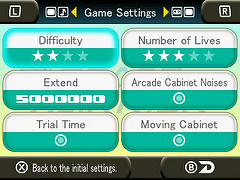
What did it mean to add stereoscopic 3D to Space Harrier?
– OK Finally we are at the point where we can actually talk about 3D Space Harrier! (laughs)
YO: Three years since we released the Wii version and it’s finally here! (laughs) Sorry for the wait!
NH: Geez, that was a super long leadup! (all laugh)
YO: When the Nintendo 3DS was released, it included Virtual Console on it, which led us to start working on Space Harrier. At the same time, Nintendo indicated to us that they were looking for games that also use 3D. I thought, “Man, I want to do that.” So I went to Horii-san and said “We’ve got to do this 3D thing,” and he burst my bubble saying, “Oh come on, that’s ridiculous! Do you have any idea how much trouble that’d be to do!?” I took a look at the sample 3D version of Xevious provided by Nintendo for reference, and I really wanted to do something similar, but I kept being told that re-making 2D games in 3D was a pretty big effort.
– Remaking a game originally built in 2D into 3D… tell us about that.
YO: If you want an idea of how hard it is, just consider how M2 has been building games. They’ve been using emulator techniques that replicate the hardware since the PS2 days. That’s one way of faithfully reproducing the originals, but the drawback is that it’s really hard to go back and add things to the code. For example, you wouldn’t be able to add in extra bosses, or build new stages.
NH: That’s why you won’t see extra features that were added to console or PC ports of older SEGA arcade games in the SEGA AGES ports. They weren’t in the original game.
YO: Re-making games in 3D is almost impossible for similar reasons. When you take a character sprite that was originally in 2D and bring it into a 3D viewpoint, you have to build the graphic from scratch. So for example, back in the 8-bit era, very large enemies were often displayed as backgrounds. But if you did a simple 3D conversion of an enemy like that, it would end up being on a different plane from the player character and look like it’s out on the horizon. If you want real 3D, then it’s basically the same as rebuilding the game from scratch.
NH: Some things you can change, and some things you can’t. At the time I thought we could probably build a visual copy of the game in 3D, and I wanted to. But cost-wise, there was no way it was going to happen, you know? This was back just before the 3DS release.
YO: But when I asked Horii-san if there wasn’t some way to rebuild the game in 3D, he said “Let’s do it” (both laugh)
– You guys are crazy! (laughs)
NH: Well, if you pick up the 3DS version I’m sure you’ll understand, but you feel like you’re playing the definitive version Space Harrier when it’s in 3D, right? I know we’re already there, but when I played the game, I felt like we had finally arrived in the 21st century, that’s how much of a killer app Space Harrier3D was for me. Once we knew what it was going to look like, it really motivated us when we were working on it. The whole staff put a lot of thought into how we were going to get this into 3D because we knew that if we could get it done, it was going to be really cool.
YO: M2 told me that “This is going to be really hard to develop, so be aware of that,” to which I said “Let’s do it,” and so we did. Now of course, we’re SEGA, so if we’re going to make 3D games, we had to start with a 3D shooter, which of course means Space Harrier. So there we were, working on Space Harrier for the 3rd time.
NH: That’s how we got to 3D Space Harrier. We had to recreate the game world (called Dragonland, for those who don’t know) in 3D from the graphical depth of the original arcade cabinet, which wasn’t ever made in 3D. There were people who helped and worked with development who’d never played Space Harrier before, and some told me they couldn’t get good at the game. When I asked them what they have trouble with, they’d say it was hard to tell whether objects were right in front of their character or not.
Once we had the game in 3D, the same people came back and said “OK, now I get it! I can play it now!” Hearing that made me really happy we went through with the project. We started this game because I wanted to do it, so the sales didn’t matter to us, but moments like that really surprised me.
– So by making the game 3D, it was easier to understand where enemies and objects are placed.
YO: For the PS2 version, we included a version of Space Harrier 3D originally released on the Mark III that you could play by putting in a cheat code. That game is much easier to play in 3D. When you can see things in three dimensions, you see where the background stops, and you know what to dodge, so it’s a lot easier that way. When you play the same mode in 2D, it’s really, really hard. On the other hand, one could say that 3D Space Harrier’s difficulty is a lot lower than the arcade original. The stage where you dodge the fast scrolling pillars in particular is a lot easier. Dodging enemy bullets is simpler, and you know how long you can wait before you have to get out of the way.
NH: Being easier to play is certainly one aspect. One thing I also really want people to notice is how much more spacious and expansive the game world feels in 3D. Check out the screen.
– In 3D, you only have to worry about what’s right in front of you. For 2D games you have to watch the whole screen, so the gameplay definitely changes.
YO: Yes, it’s the same game but different.
NH: There are still a lot of games that we have fun ideas for. For this game in particular though, I want to say that playing with the 3D effect off is out of the question.
YO: It’s the same for movies. If you watch the same movie in 3D and 2D, you certainly watched the same thing. But it’s a totally different experience.
– When I saw Space Harrier in 3D for the first time, I think it was a modified “3D” version of the X68000[1] release. I think the programmer must have figured out the positions and behavior of the background and sprites to build the 3D. I’m no expert though, so I’m just guessing. Still, for 3D Space Harrier, I imagine M2 had to get in there and actually fiddle with the ROM itself to get the arcade version running. How did you create the 3D effect? You’d need to understand not only the architecture of the original hardware and software, but also understand the structure of the hardware you’re porting to, as well as modifying your emulation engine, right?
NH: Yes, that’s right. You have to understand the underlying game before you can add things on top. For this project, we did it all using a method that’s similar to emulation, however strictly speaking, it’s not emulation.
YO: At the core, there’s a program running that’s based on emulation techniques.
NH: Specifically, the code that ran on the arcade CPU, the MC68000, isn’t used in 3D Space Harrier. Replacing that code allowed us to finally get the 3D working.
YO: That’s what we mean when we say this game is the result of all of the hard work and technical skill developed up until now.
NH: Since we could take our time with Space Harrier 3D, we were able to do things like support wide screen.
YO: Wide screen support in this version is a first for any port of Space Harrier. The only other game we’ve done that supported wide screen was the PS2 version of Galaxy Force II.
NH: For game design reasons, Harrier’s movement range is the same as it always was, but it just feels better to play in wide screen.
YO: This is the 3rd Space Harrier I’ve requested from M2, and it might really be the last Space Harrier, or at least the last port. So we wanted to make it the definitive version. When we were interviewed for the PS2 version of Space Harrier II, we said that if you bought the PS2 version, you’d never need another version, but 7 years has passed, and well… turns out there was still a lot of work to be done. (laughs)
NH: I thought about it a lot, and after that the PS2 version was done, I told Okunari-san that I wanted to go and play the arcade kit in storage one more time. So I did, and while I was there, I put up a microphone next to the kit’s motor and recorded the motor sounds.
YO: Wait, you went just to record some sounds? (both laugh)
NH: Yeah, so? (laughs) When you play [3D Space Harrier] in arcade mode[2], you’ll hear sounds we put in, which are me hitting the buttons and the motor running. In that sense, this version’s got some funny quirks to it.
[10] The X68000 was a home computer made by Sharp Corp and released only in Japan in 1987.
[11] 3D Space Harrier features the ability to turn on sounds the arcade machine makes as well as have the screen gyrate as it would if you were playing a real arcade cabinet.
– Maybe in the future, we’ll have consoles that let you play in 3D, and you can reproduce the whole cabinet and feel of the arcade in your living room…the ideas are endless.
NH: Since you can install games to hardware nowadays, something I’ve always wanted to do is take all the sounds from the games you own and recreate the cacophony of lots of attract screens in an arcade. You could make something like a virtual arcade.
– Recreate the entire atmosphere of the arcade, I see.
NH: It’s not in the cards at the moment, but it’s something I’d like to try one day. In any case, there’s tons of stuff I want to do. Like Thunder Blade or something. If there are 2,560,000 people out there who want that, I think SEGA would be happy to let us do that for them.
YO: Let’s consider it if 3D Space Harrier sells that many copies. Heck, 256,000 people would be fine. (both laugh)
– OK well it looks like our time is about up. Can you guys sum up the key points of Space Harrier 3D for us?
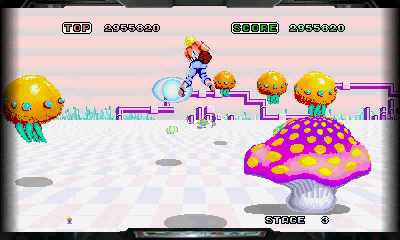
YO: For Space Harrier 3D, it all comes down to the 3D support we’ve added that took so much effort as we described earlier. And it’s not a copy by eye, it’s based on the original code base, and it plays just the same. It’s also the first time Space Harrier has ever supported wide screen. And there’s also M2’s excellent arcade mode.
NH: I hope people reading this to give that mode a try. It’s fun and brings back a lot of memories.
YO: When that mode first went in, I said to Horii-san, “Since the cabinet’s chair moves with the monitor in the arcade version, the screen shouldn’t actually tilt, right?” Remember?
NH: Yeah yeah, I know. But, we’re talking about nostalgia here, you know? (laughs)
YO: So that part doesn’t quite match up with reality, but it definitely has an “ambiance” and it’s fun. Oh and the arcade kit sound effects are there too.
NH: The arcade cabinet’s motor watches the signals from the original arcade board, so it knows when you’re moving right, or when you’re moving left. The sound effect timing is all the same as the original.
YO: In addition, the background music quality has really improved, and we’ve finally put in an equalizer. We didn’t ask for it but M2 threw that in as an extra. (laughs)
NH: If you play around with the equalizer, you can get pretty close to the original arcade feel. Players can use it to recreate the same environment that they remember.
YO: There are presets too. I hope people give it a try.
NH: Okunari-san might think we had a lot of free time on our hands by including the equalizer. (laughs)
YO: Even just playing it as-is out of the box, I think this port probably has the best sound reproduction than any previous one. This is in large part due to Manabu Namiki’s [1]involvement, right?
NH: Yes, Namiki-san checked the game until the very end. The extra song as well.
YO: Since M2 had hired Namiki-san around that time, he participated in the project as an internal staff member, and he was able to give the game really thorough oversight. The arcade environment sound idea started with him, right?
NH: Yeah, he had a lot to do with that. He’s the one who put out the idea for the arcade kit sounds. The motor and button sounds.
YO: For those sounds, you can’t just put a mic down and record them because there’s all these other loud sounds that get in the way, so we had to turn off all the cabinet’s fans and record the right, front and rear sounds over and over. Then we took the best samples out of those and included them. Same for the button sounds. Typical players might not care about this sort of stuff, but I hope there’s maybe one in a thousand who will really be into it. Every time this game is ported, people tell us “It’s not really Space Harrier without an arcade kit.” That’s totally true. However, since we can’t port the kit itself, we do what we can outside of that and this is how it turns out. So in a certain sense, 3D Space Harrier is our answer to that problem.
[12] Manabu Namiki is a Japanese video game composer.
– I see.
YO: Also, and this is a sort of down to the nitty gritty, but there was a bug in the PS3 and Wii versions where certain sound effects would play and not stop. It was in the original arcade game, and we’ve made the decision to fix it for this version. Up until now, we’ve prioritized reproducing the original arcade board as faithfully as possible, but now that it supports wide screen and 3D, the 3DS version no longer reproduces the original per se, and it wouldn’t be ideal for a first time player to run into a bug like that. So we fixed it. We also don’t force any sort of slowdown replication on the game. So I think it’s safe to say that this is the perfect version of Space Harrier.
– From what I’ve seen, I’m certainly hoping that’s the case.
YO: Lastly, if you watch the porting staff credits, you can find out all the names of enemies that appear in the game. We often heard from the fans that they wanted to know the enemy names, so M2 put in a little sequence that shows off the original character names. The names come from a 10 year old game called Typing Space Harrier, where you had to type in the character names. Most of the characters besides bosses didn’t have names at the time, so Yu Suzuki named them. So these are official enemy names from the game designer himself. I had no idea about this until the guy who made Typing Space Harrier told me. I think fans of Space Harrier will be really happy about it. I mean, I could just go on and on. (laughs)
– Alright, sounds like there’s still more to talk about.
Naoki Horii (below, NH): You know, for the Space Harrier arcade machine on the menu screen, what I really wanted to do was use the AR feature to put a Space Harrier machine in my room.
Yousuke Okunari (below, YO): We totally ran out of time for that one… (laughs)You know, when we were making the arcade machine’s model on the menu screen, we didn’t have any pictures of the cabinet from all three sides (front, back, side). I think we had the design layout for it, and pictures from certain sides only, but we didn’t have one from the front. However, awhile back, Dreamcast Magazine made a papercraft version of the cabinet, and wanted to put a picture of it in Space Harrier II’s manual for PS2. They had lent us some photos they were using to make the papercraft, which came in very handy. Thanks Umeda-san! (laughs)
… However, there’s actually a difference between the papercraft cabinet and the model in-game. Can you guess what it is? It might be hard because it’s spinning around.
– Hmm, I don’t know…
YO: See here on the back of the seat, there’s a little portion that looks like an exhaust pipe. On the machine in the warehouse that they photographed for the papercraft, it’s white. But on an actual arcade machine, there’s a light there which flashes red. It seems that the machine we keep in the warehouse is one of the first models, a prototype or a preproduction model, or something, but anyways there’s a light in the middle. Also, the one in the warehouse doesn’t have the gameplay instruction plate under the monitor. M2 noticed that later on and drew one up for us.
Other than the papercraft one, there was a toy version of the Space Harrier arcade cabinet built for UFO Catchers[13] as well, and that one has the white portion as well. We went out to some modern arcades and took pictures, and when you compare them, you can see the difference. I also asked M2 to redo the cabinet on the title screen once as well. You can’t really tell by looking at two dimensional photos, but once it was put into 3D, the differences in the molding were pretty apparent.
[13] Often called ‘claw crane’ games in the West.
– So you had to make some more changes. You guys really get deep into the details. (laughs)
YO: Maybe we should talk about the controls too? The slide pad controls are similar to the arcade in the sense that once you let go of the slide pad, the stick goes back to neutral. But if you’re using a d-pad, it’s more console-like because when you let go, Harrier will stay in the same position. This has always been the case with previous ports. For people who played in the arcade, they’ll be used to having the stick return to neutral, but that’s not the case for console players. Oh and also, for this version, we’ve added touch screen support.
– I really appreciated having the slide pad and d-pad controls active at the same time, and being able to switch between them on the fly. Rapid fire is included as well, and playing on the touch screen is easier than one might expect.
YO: You can also toggle character movement between normal and reverse, and switch between three levels of auto-fire. B button is the auto-fire button, or you can touch the screen to use auto-fire. This game is really a testament to M2’s abilities.
The arcade version of HAYO OH, unleashed at last!?
YO: And finally, since we have this opportunity, I’d like to talk about some additional content we’ve included in the 3D version as well.
– … What?
NH: We’ve added the final boss from the Mark III version of Space Harrier, HAYA OH, in true arcade style. You can call it a reward for players that push the game really hard. HAYA OH’s music is played through the arcade sound generator as well. I hope it’s a nice surprise when you run into him in game.
– Oh! Was that the ‘extra song’ that you referred to in our previous article?
NH: Yes, we were checking that track up until the very end.
YO: It doesn’t come out quite as crazy as the original… But you know, it seemed like there was some rule about the Space Harrier ports where HAYA OH would never be included in the arcade modes. M2 and myself really wanted to do something about that. At first we thought we couldn’t. But then we said, “let’s make it happen.”
NH: You know, if we hadn’t put HAYO OH in, we might have been able to get this game out last year… Just kidding. (both laugh) Anyways, he’s in there.
YO: This is what you get when you grumble about things for a straight year.
NH: We built HAYO OH per the original arcade programming. We basically went in and fiddled with the programs for SQUILLA and GODARNI[14] and were able to get HAYA OH working. I think it’s pretty impressive if you consider that HAYA OH is working on top of the original program. Like, this would probably actually work on the original arcade board. That’s the level at which we built it.
YO: Did Mr. Namiki do the song arrangement?
NH: The main programmer, Akira Saito[15], made the arrangement, and then Mr. Namiki came in and advised on specific parts of the track. If you know their work and give it a listen, I think you’ll be able to hear the synergy between them.
[14] SQUILLA and GODARNI are the 1st and 3rd stage bosses, respectively.
[15] Mr. Saito is a programmer at M2, who was in the past was involved in creating sound drivers for the X68000.
– Sounds like a team-up that’ll make a lot of people happy.
YO: For the 3DS port, we’ve made changes to the game specs from the PS2 and Wii Virtual Console versions. We wanted to keep some of the gameplay tension, so we got rid of unlimited continues. So to get HAYO OH to appear, you need to get all the way to stage 18, starting from stage 1. You can change the number of lives and difficulty any way you want and use all 3 continues, but that’s the underlying condition.
We also put in a stage select for stages you’ve already cleared. So if you start on Stage 18 and beat VALDA without dying, you’ll fight HAYO OH.
If you can beat him, a menu item labeled “special” will show up. You can turn this off to prevent HAYA OH from appearing when you fulfill his requirements. Also, this options lifts the usual 3 continue limit and you’ll have unlimited continues. So it’s a bit more arcade-like that way.
– Sounds like something I can look forward to. So is the “SEGA 3D Remake Project” going to keep going?
YO: Well a lot of that will depend on how 3D Space Harrier does, but since we think it turned out great in 3D, we’re going to continue development along this line. Lots of people are guessing which games we might do next, and we want to make some of those titles happen. But there are going to be some titles that make people say: “What? You’re going to remake that in 3D?” I’m looking forward to seeing the reaction.
That said, as I mentioned early, actually remaking games in 3D is very work-intensive and difficult compared to putting games out on the Virtual Console. It’s similar to when we were originally porting things to PS2. It’s the same with porting Game Gear titles to Virtual Console, but the amount of games we can keep putting out depends on how fans react. Personally I keep we can just keep going and going.
We started developing the SEGA 3D Remake Project at the same time as the 3DS Virtual Console. Game Gear got started in March of this year [16], and there’s been over 10 titles that have gone up for it on Virtual Console. We want to keep working next year to get games out for the Virtual Console and the SEGA 3D Remake Project.
NH: Going forward, I want to put a lot of polish into the 3D, and take our time releasing whichever ones seem profitable. I want to take the games that people think would be fun to play in 3D, build them well and get them out in the wild. I hope everyone will support us.
[16] 2012 was the date of this article, so March 2012 for the Japanese Game Gear Virtual Console.
– From here on out, do you expect the 3D remake work to get more efficient as you continue to release more of these games?
NH: Since we’ve built a shared architecture that’s the basis for our ports, we expect things to pick up. It also depends on the pros and cons of the particular game we are working on.
YO: Yeah, there are titles that people think would be absolutely amazing in 3D, but if you ported them, the graphics would look totally wrong in 3D. So to get a game like that into 3D, you’d be better off building it from scratch off a visual reference. So then the next question is what’s the most efficient way to do that. In any case, there are some follow-up games that I really want to get out, so the series won’t end with Space Harrier.
NH: There could be a game that has a ton of fan support, for which we’ll forego the shared architecture and spend the extra time remaking it on its own.
– If that happens, it might be hard to put a price on it, don’t you think?
YO: Well, Space Harrier is Space Harrier, so we wouldn’t be able to justify a significant price difference from what we already have on Virtual Console. We’ve heard a lot of people wonder how many times they can actually buy Space Harrier, but this time the game is in 3D, which really showcases how different it is from previous ports. We hope everyone gives it a shot.
NH: Definitely.
YO: Thank you for your support!
– Thank you very much as well!
(C)SEGA
Copyright ©2013 Impress Watch Corporation, an Impress Group company. All rights reserved.
Ad:
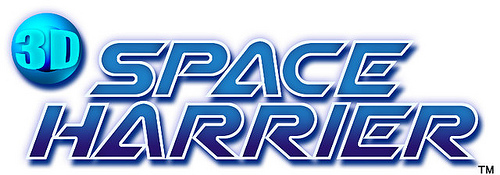
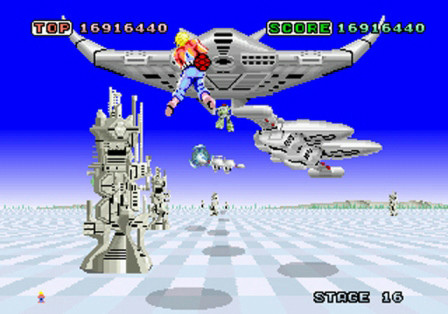
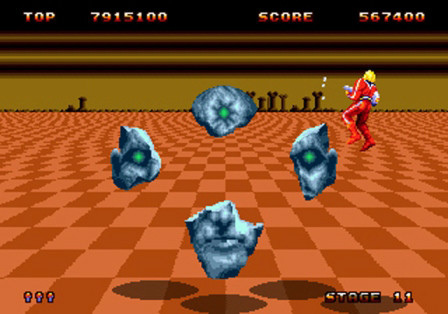


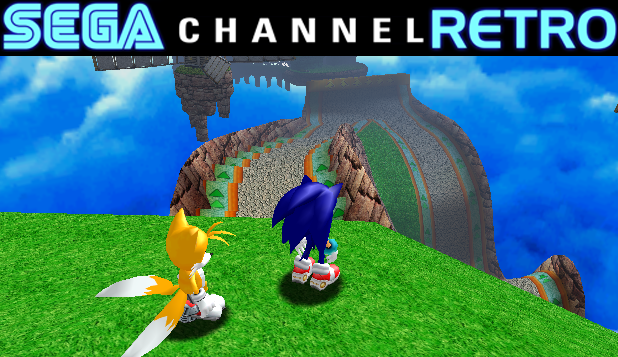
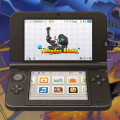
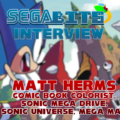
I love this interview series! I actually saved them and then formatted them to print out into little zines.
Just an FYI for anyone who’s not familiar with Space Harrier – they accidentally included an image of Space Harrier II in here – the boss that is a face split into four pieces. (I assume this was a mistake originally made by GameSetWatch. The interview doesn’t actually mention Space Harrier II.)
Do you have these interviews posted anywhere online to read, seems the Sega blog is gone now…
I remember this game. Because this game is the main reason I imported a Japanese 3DS after a year passed without no news whether the game would be localized or not (was localized in the end but it was too late).
Sorry, I call BS on the whole ‘definitive version” and the characters didn’t have names…
Ever finish playing on an original gameboard in a cabinet? The enemies DO have names. And the cabinet IS the definitive version. Not some handheld device with a small screen.
Where are the other interviews? Those were amazing!